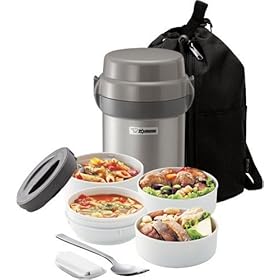
My daughter, a student who agrees to have lunch with friends at school "suck" is sold in this regard. She wanted to lose a few pounds, which contributed to the work, despite the fact that there are now eating larger quantities of food during lunch.
How? She, like all his friends used skip lunch and leave school hungry, scarfing the first things you could get its hands - usually high in fat, junk food, high calorie. Lunch box has been eliminated after school munchies, keeping your appetite in check all day. For the first time, it can pack hot (or cold) nutritious lunches at 6:30 am, and they are still very hot cold ice (a) when the draw out his locker at 11:30. His friends, good humor mocked her space capsule "lunch at first, now crowd around her during lunch with his tongue hanging, online games for your scrapbook. One said:" The lunch box of the same size as my water bottle, but you have to, as , 4-gourmet meal in there. "
Lost 10 kilograms in 2 months since she began taking her to dinner in a jar Zojirushi has gained notoriety among their peers as the best dinner "never" have become more friendly and less tart (better nutrition) and dancing in a period of 4 waiting for the bell to signal a period of dinner, where they can spread their containers before they are jealous friends to admire and hold court over a surprise gourmet meal, trying to decide what to eat first. In his own admission, has more energy and better concentration in the classroom and during the study (his grades are up, by the way). He admits that the pain is to have one more to carry, in addition to your bag (no, that does not fit, but the bag is already packed tight with books), but swears that this award makes it worth less. As a parent, it pleases me to see myself described "lazy people on earth" hunkered over the sink at night, with love and careful cleaning of each container and the cover (no doubt thinking of the delicious and healthy treats that contain tomorrow).
Such a good buy, I bought a different model Zojirushi more suitable for my 11-year old daughter. My children say that they never come back for lunch in the cafeteria of the school, and become more aware of nutrition and involved in preparing a meal. While his friends spend half a lunch break opportunities in line for entries in bad taste and overprocessed loaded with salt, sugar and refined carbohydrates, my children for lunch in the vegetarian hot chili Cornbread / butter, a delicious main dish salad with homemade dressing and Pita hummus sandwiches and teriyaki stir fried vegetables, rice or whole grains. And this is only the bottom 2 boxes! Top 2 boxes are perfect for fruit, chips, nuts and / or healthy desserts, all items in the middle and high school love to eat. I am pleased with the product, which is solidly built and works just like advertisied, even better results if you have heat or pre-cooling tank for 5-10 minutes. We shall stick to a set of plastic cutlery that fits well in a vertical position to support the fabric, with lines extending to the middle.
NOTE: The other reviewer was a bit annoyed user documentation in Japanese only, but the name of the company at its headquarters in California (800-733-6270) and they promptly sent fax to English instruction. Do not let me in this way to save money by eliminating expensive meals and packaged food. Zł, perfect, who has already paid ten times.


